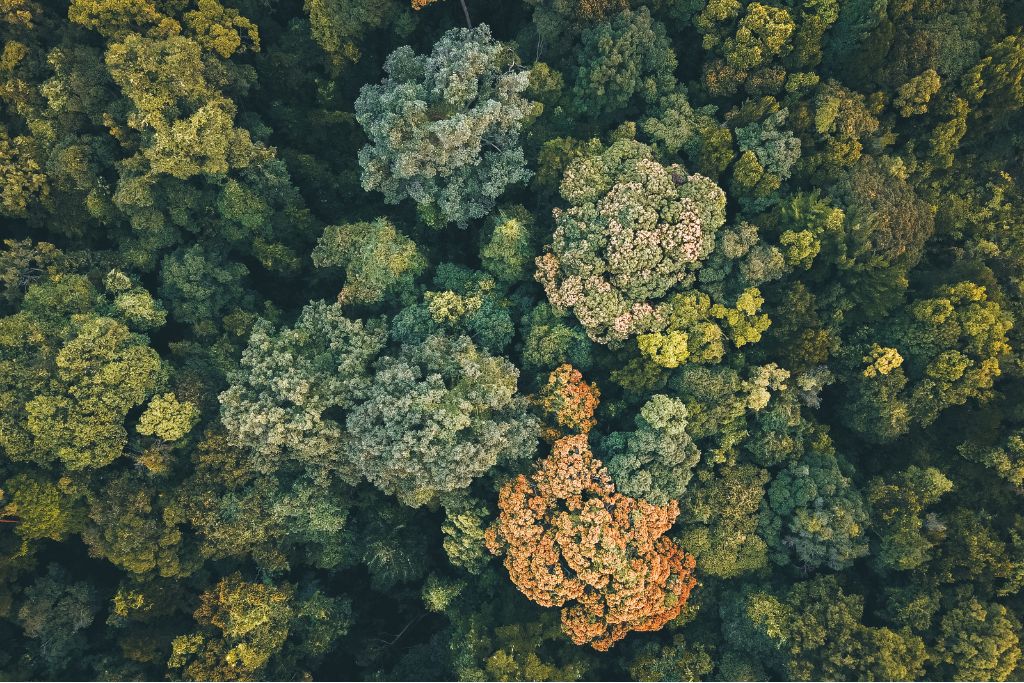CRAWFORDSVILLE, Iowa — A few years ago, Holly Jones started studying the micro-climate and the topography on her family farm in Crawfordsville, Iowa, about 40 miles south of Iowa City. Jones said learning more about the landscape of her fifth generation flower farm helped her recognize some of the ways weather and climate change could affect her operation.
“There are some areas of our land that are a little higher than others,” Jones said. “That’s going to impact, for example, when we’re looking out for frost advisories or frost concerns really early in the season or the end.”
Around this time, the U.S. Department of Agriculture updated its plant hardiness zones map, which divides the United States into 13 zones based on average annual minimum temperatures in a given time period.
Todd Einhorn, an associate professor in the Department of Horticulture at Michigan State University, said simply put plant hardiness zones help gardeners and farmers determine which plants are most likely to survive winters in a specific location.
Jones’ farm, called Evergreen Hill, is currently in zone 5b. The USDA found that for her area the temperature had increased by one degree Fahrenheit between 2012 and 2023 – a trend experts say will continue in the Upper Midwest.
In response to the changing climate and her deeper understanding of her land Jones created “crossover plans” for the farm, planting flower varieties with overlapping bloom times. If one species is late to flower or runs its course early, she has other plants that can fill in as the farm’s “focal flower” at any given time.
Jones works to be transparent with customers about whether they can have certain flowers by a specific date when she takes orders.
She said she and her team have learned that they must be flexible when it comes to farming in a changing climate since she does not have control over growing conditions.
“We can prepare as much as we want, but there’s so much variability now in growing, especially in the ways that we grow that you just have to be prepared to pivot and adapt,” Jones said.
Jones won’t be the only one adapting.
Plant hardiness zones are shifting northward nationwide as the country continues to warm, affecting farmers, gardeners and producers across the country. The biggest changes in the coming decades are predicted to be in the Upper Midwest. The Midwest produces 27% of the nation’s agricultural goods.
What are plant hardiness zones?
The USDA Plant Hardiness Zone map has 13 zones, which serve as guidelines for growers on what kind of plants will grow well in their area.
“Hardiness zones are meant to at least delineate which species or cultivars of species could be planted based on their survival,” Einhorn said, who specializes in plant hardiness science, particularly with fruit tree species.
Each zone covers about 10 degrees – for example, Iowa lies primarily in zone 5, which means its coldest temperatures range from -20 degrees to -10 degrees Fahrenheit on average. Each zone is further divided into five degree half zones – the northern half of Iowa is in 5a, the southern half in 5b.
Madelynn Wuestenberg, an agricultural climatology extension specialist with Iowa State University, said that plant hardiness zones are defined by their average coldest temperatures. The averages are calculated over 30 years.
In 2023, using new averages, the USDA updated the map, moving about half of the country up by half a plant zone, meaning average minimum temperatures rose by zero to five degrees in the affected places.
Why are the zones shifting north?
Climate Central, a non-profit researching climate change and how it affects people, analyzed 243 locations around the United States and found that about 67% of the locations studied based on National Oceanic and Atmospheric Administration data have already shifted to warmer planting zones from the mid-1900s to present.
The researchers found that the Northwest and the Southwest, along with Alaska, have been the most affected to date.
With unabated climate change about 90% of locations examined will likely shift to warmer planting zones by the middle of this century. The Upper Midwest is predicted to be affected most.
Wuestenberg said winter temperatures in the Midwest are becoming warmer on average, compared to decades past.
“What we saw from the 1981 to 2010 climatology versus the 1991 to 2020 climatology is we’re really starting to see warming across the U.S.,” Wuestenberg said. “And this has been observed for a long time, and really it’s a pretty consistent overall warming, but the specific amount of warming varies region to region across the U.S.”
Of the cities with the highest predicted temperature change between now and mid-century, a majority of the top 25 are in the Mississippi River Basin.
Madison, Wisconsin, for example, is projected to switch from zone 5b to 6a as the average coldest temperature is expected to increase by 8.4 degrees Fahrenheit.
 Using data from the National Oceanic and Atmospheric Administration, Climate Central analyzed how rising temperatures might change growing conditions around the country. They found that if climate change continues unabated, 90% of their studied cities will shift to warmer planting zones by mid-century, including Madison, Wisconsin. graphic courtesy of Climate Central
Using data from the National Oceanic and Atmospheric Administration, Climate Central analyzed how rising temperatures might change growing conditions around the country. They found that if climate change continues unabated, 90% of their studied cities will shift to warmer planting zones by mid-century, including Madison, Wisconsin. graphic courtesy of Climate Central
Jefferson City, Missouri will likely change from zone 6b to zone 7b, as the area’s average cold temperatures are projected to increase by 8.3 degrees Fahrenheit.
 Using data from the National Oceanic and Atmospheric Administration, Climate Central analyzed how rising temperatures might change growing conditions around the country. They found that if climate change continues unabated, 90% of their studied cities will shift to warmer planting zones by mid-century, including Jefferson City, Missouri. graphic courtesy of Climate Central
Using data from the National Oceanic and Atmospheric Administration, Climate Central analyzed how rising temperatures might change growing conditions around the country. They found that if climate change continues unabated, 90% of their studied cities will shift to warmer planting zones by mid-century, including Jefferson City, Missouri. graphic courtesy of Climate Central
In Dubuque, Iowa the average coldest temperatures are expected to rise by 8.3 degrees Fahrenheit and producers will go from zone 5a to 6a.
Average cold temperatures in Cedar Rapids, Iowa are on course to warm by 8.2 degrees Fahrenheit and the region is expected to jump an entire planting zone to 6a.
 Using data from the National Oceanic and Atmospheric Administration, Climate Central analyzed how rising temperatures might change growing conditions around the country. They found that if climate change continues unabated, 90% of their studied cities will shift to warmer planting zones by mid-century, including Cedar Rapids, Iowa. graphic courtesy of Climate Central
Using data from the National Oceanic and Atmospheric Administration, Climate Central analyzed how rising temperatures might change growing conditions around the country. They found that if climate change continues unabated, 90% of their studied cities will shift to warmer planting zones by mid-century, including Cedar Rapids, Iowa. graphic courtesy of Climate Central
The shift in plant hardiness zones could force some growers across the country to select plants that are adapted to a wider and warmer range of temperatures to survive warmer winters and earlier frosts and thaws.
In some cases, that could mean new opportunities.
Dean Colony runs Colony Acres Family Farm in North Liberty, Iowa. On his 200-acre farm, he grows pumpkins, corn, soybeans and zinnias.
His farm is currently in plant hardiness zone five, but Colony said it could be a matter of time before Iowa is able to produce peaches like Missouri and Kentucky can.
“How many more years is it going to be? I mean, we could grow peaches in Iowa, but it seems like they grow them way better down there,” Colony said. “So is it a matter of time before that comes here.”
Wuestenberg said one challenge with the shifting zones is that they are based on climatological averages and do not take atypical and significant frost or freeze events into account, which can be challenging for producers.
Who will be most affected?
Wuestenberg said gardeners and fruit tree producers will likely be more concerned about the shifting zones, rather than row crop producers.
Fruit trees and vines need a certain number of chilling hours, which is the minimum period of cold weather a fruit tree needs to blossom.
For example, Einhorn said most apple trees require about a thousand chilling hours in the winter to break their dormancy period and bloom in the spring.
But with winters warming, even by a few degrees, apple trees will want to break dormancy earlier..
“Instead of being at 30 degrees Fahrenheit in the winter, maybe now the days are at 34 [degrees Fahrenheit] and that little bit of warming actually has a humongous effect on a tree,” Einhorn said.
The apple trees could start flowering in late February or early March.
“Unfortunately, what can happen is overall, winter may have been warmer, but we still might get a March, April frost. And once that happens, those buds, those flowers, are exposed to that cold temperature, and then it kills them,” Wuestenberg said.
This could lead to reduced fruit yields later in the season.
But Einhorn said there are ways that producers can work within the unpredictable conditions.
For example, there are various methods for raising temperatures for trees during a freeze, including using fans to pull warm air out of the atmosphere and running water over plants. There are also research efforts underway breeding new plants that have either delayed blooms or can withstand the new conditions.
Meanwhile, farmers will continue to adapt. Jones, the flower farmer, has noticed strong winds and storms coming through the Eastern Iowa region. She’s planted sunflowers in windier areas of the farm because they can withstand stronger gusts. More delicate flowers go near trees for natural protection. She also uses netting to help stabilize flowers from winds, rains and storms.
“At the end of the season, we’re at the mercy of our climate and the weather,” Jones said. “And that can greatly impact what we have in any given season.”
This story is a product of the Mississippi River Basin Ag & Water Desk, an independent reporting network based at the University of Missouri in partnership with Report for America, with major funding from the Walton Family Foundation.
Type of work:
News Service Produced externally by an organization we trust to adhere to journalistic standards.









 English (US) ·
English (US) ·